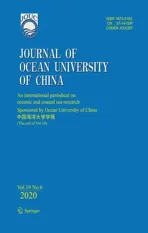11000-Year Record of Trace Metals in Sediments off the Southern Shandong Peninsula in the South Yellow Sea
2020-11-30QIUJiandongLIUJinqingLIMeinaCAOKeWANGShuangandYUENana
QIU Jiandong, LIU Jinqing, LI Meina, CAO Ke, WANG Shuang, and YUE Nana
11000-Year Record of Trace Metals in Sediments off the Southern Shandong Peninsula in the South Yellow Sea
QIU Jiandong1), 2), LIU Jinqing2), *, LI Meina1), CAO Ke1), WANG Shuang1), and YUE Nana3)
1),,266071,2),,266590,3),,266061,
Geochemical background values are the normal concentration of trace metals in the natural environment and sediment cores have been proved to be excellent samples to get these values. The trace metal (Cu, Pb, Zn, Cr, Cd, As, Hg, Ni, Li, and Co) concentration profiles along a sediment core are investigated to get the background values and to assess the depositional processes and contamination levels off the southern Shandong Peninsula, China. All the metals, except As and Hg, had similar concentration profiles with the highest average values during the period of 6–3kyr. The high concentrations of As and Hg occurred before 6ka and during the period of 3–0kyr. The difference in metal concentrations before and after 6kyr was mainly attributed to the source of core sediments, which are derived from proximal sediment on the Shandong Peninsula before 6kyr and the mixture of proximal sediment and Yellow River sediment after 6kyr. The effects of particle size and human activity were mainly contributed to the metal concentrations since 6kyr. The average concentrations of trace elements in sediments between 6 and 3kyr were selected as background values. The principal component factor analysis indicate that the metals were from the natural sources throughout the observed depositional period, with the exception of As and Hg, which may had anthropogenic sources for the sediments from the bottom 2m of the core. Their geoaccumulation indices indicate that the sediments were not contaminated for Cu, Zn, Cr, Cd, Pb, Ni, Li and Co, whereas they were contaminated recently for As and Hg due to the regional civilization and human activities.
trace metals; core sediment; Shandong Peninsula; South Yellow Sea
1 Introduction
With the development of human civilization, environmental pollution problems associated with heavy metals have spurred worldwide concern since the middle of last century. Trace metals possess various physical and chemi- cal properties, and coastal sediments may act as their sinks or sources (Mao., 2010; Shen., 2012; Veerasingam., 2015). Both natural and anthropogenic sources, mainly industrial and agricultural activities, have inputted large amount of trace metals for coastal sediments, which directly influence coastal ecosystems (Liu., 2013; Cao., 2017; Qiu., 2018; Shen., 2018; Gu., 2019). Temporal variations of the metal concentrations in the sediments reflect the geochemical history in a given region, including any anthropogenic impact. Sediment cores are useful in evaluating the influence of anthropogenic and natural processes on the depositional environments, and elucidating the pollution histories of aquatic ecosystems (Gu and Lin,2016; Xu., 2018). Se- diment cores from coastal areas provide useful chronological contamination records (Li and Li,2017), which can improve our understanding of trace-metal emissions and aid policy makers in promulgating regulatory requi- rements that are intended to reduce potential health risks.
The coastal area off the southern Shandong Peninsula, located in the northwest of the South Yellow Sea, is a tectonically stable shelf area (Wang., 2013) that is impinged by several current systems in the Yellow Sea and nearby regions (Fig.1). The Yellow Sea and North Jiangsu Coastal Currents primarily flow southward along the western coast of the Yellow Sea during summer and winter, with local convergent-divergent tidal currents occurring over the tidal sand ridges in coastal Jiangsu (Li., 2001).
Large amounts of surface sediments (Xu., 2012; Yuan., 2012, 2018; Li., 2013; Liu., 2015; Liu., 2019) have motivated many heavy-metal pollution studies off the southern Shandong Peninsula, but his- torical variation trends of trace-metal concentrations in the sediments are poorly understood due to a lack of long drill cores. Here a sediment core from the coastal area off the southern Shandong Peninsula was studied with the aims of 1) getting the background values and establishing the vertical distribution of trace metals in the Shandong Peninsula coastal sediments; 2) assessing the trace-ele- ment enrichment factors in the sediments; 3) assessing the historical contamination trends in the Shandong Peninsula coastal sediments through geoaccumulation indices; and 4) delineating the lithogenic and anthropogenic sources of the metals in the sediment core.

Fig.1 Bathymetry map and regional circulation pattern (during winter) in the study area. The red dashed rectangle denotes the area shown in Fig.2. KC, Kuroshio Current; YSWC, Yellow Sea Warm Current; TWC, Taiwan Warm Current; YSCC, Yellow Sea Coastal Current; SKCC, South Korean Coastal Current; NJCC, North Jiangsu Coastal Current; ECSCC, East China Sea Coastal Current.
2 Materials and Methods
2.1 Sediment Collection and Sampling
The sediment core QDZ03 (120˚56΄58.77˝E, 36˚16΄03.21˝ N; Fig.2) was collected in 2011 by using a rigging drill by drilling vessel. The 40.2-m-long core was acquired at the 15.50m water depth (Fig.3). Core recoveries were better than 87% for mud-dominated segments and 60% to 90% for sandy intervals. The core was split leng- thwise, visually described, and subsampled in the laboratory. In this study, we focused on the upper 10m sediments of the core. Subsamples were taken at 10–12cm intervals for grain-size and elemental analysis.
2.2 Sediment Analysis
Ninety-six core samples were analyzed at the Center of Testing, Qingdao Institute of Marine Geology, China Geo- logical Survey. The grain size distribution was determined by using a Malvern Mastersizer 2000 laser particle-size analyzer (Malvern Instruments Ltd., UK) and standard sieving methods after pretreated with 10% H2O2and 0.1 mmolL−1HCl to remove organic matter and biogenic car- bonate, respectively. The samples were oven-dried at a constant temperature (<60℃) and ground to powders of <63μm for elemental analysis. The concentrations of four major elements (Al, Fe, Mn, and Ti) and six trace elements (Cu, Pb, Zn, Cr, Co, and Ni) were determinedX-ray fluorescence spectrometry. The Cd concentrations were determinedinductively coupled plasma-mass spectro- metry, and the As and Hg concentrations were determinedatomic fluorescence spectrometry. The analysis qua- lity was checked with parallel sample analyses, yielding relative errors of <5%.
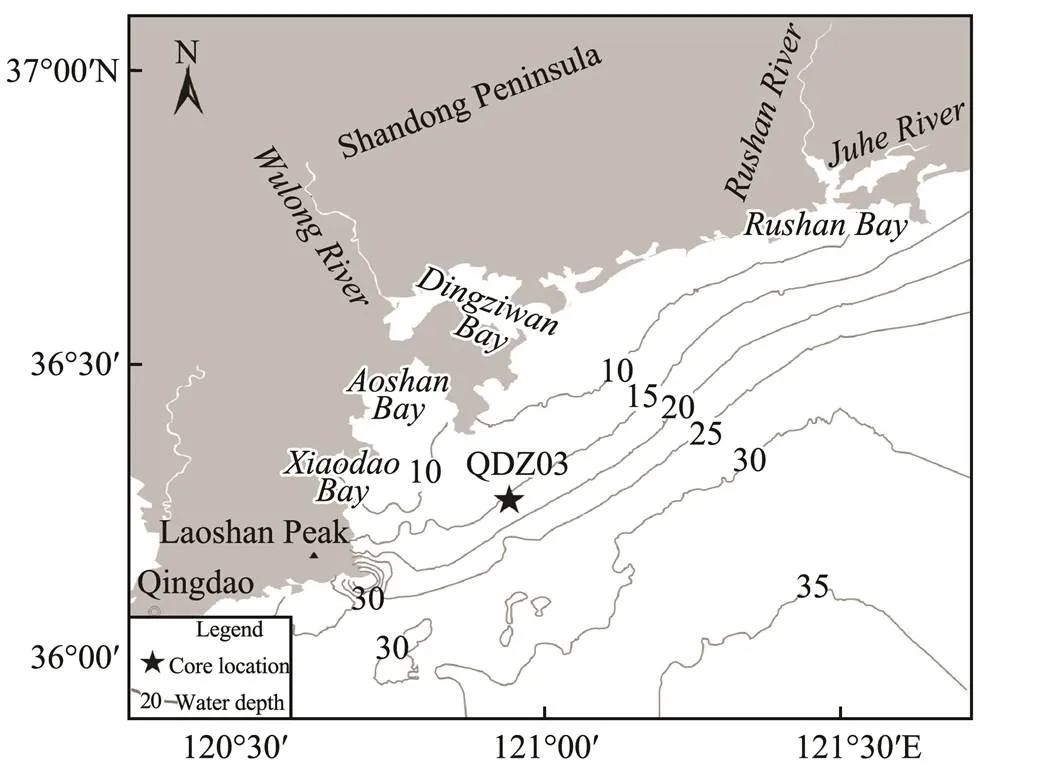
Fig.2 Location of the core QDZ03 off the southern Shandong Peninsula.
Radiocarbon (14C) ages were determinedaccelerator mass spectrometry (AMS; Beta Analytic) for ten shell samples throughout the core (Table 1). The ages were cor- rected for the regional marine reservoir effect (Δ=−100±36yr), as determined for the western and eastern Yellow Sea by Southon. (2002), and calibrated by using Calibration Revision 7.0.2 (Stuiver and Reimer, 1986–2014). The calibrated ages are reported as calendar14C ages before AD 1950 (calyrBP) with one-standard-deviation (1s) uncertainties.
2.3 Evaluation Method
The metal enrichment factor (EF) was used to assess the degree of metal enrichment and contamination in sediments. EF values were calculated by the ratio of the metal concentration in the sediment to its natural background. Al was used as the reference element because of its conservation in the sediment and derivation from primarily natural sources.
EF values were calculated by using Eq. (1):

where Mesample and Alsample represent the trace metal (Cu, Pb, Zn, Cr, Cd, As, Hg, Ni, Li, and Co) and Al concentrations in each sample, respectively, and Mebaseline and Albaseline represent the background trace metal and Al concentrations, respectively, chosen as the average concentrations in the upper continental crust of North China (Xia, 1987; Gao et al., 1998). The EFs lower than 1.5 are indicative of metals related to crustal sources, whereas those larger than 1.5 implythe remarkable contribution of anthropogenic sources (Zhang and Liu, 2002).

Table 1 List of AMS14C ages of sediments from core QDZ03a
Note:aAfter the reference Qiu., 2014.
The geoaccumulation index (geo) is commonly used to assess trace-metal contamination in sediments, and is cal- culatedEq. (2):

whereCrepresents the measured concentration of trace metalin the sediments andBis its geochemical background level, with 1.5 accounting for possible variations in the background data due to lithogenic effects. Thegeovalues are used to assess the degree of trace-metal contamination, with<0, 0–1, 1–2, 2–3, 3–4, 4–5, and >5 representing unpolluted, unpolluted-moderately polluted, moderately polluted, moderately-strongly polluted, strongly polluted, strongly-extremely polluted, and extremely polluted sediments, respectively.
3 Results and Discussion
3.1 Downcore Variation of Trace Metal Concentrations
In this study, we focused on the upper 10m sediments in the core, which mainly deposited during the Holocene according to the AMS14C ages (Qiu., 2014; Table 1). The mean Cu, Pb, Zn, Cr, Cd, As, Hg, Ni, Li, and Co concentrations in the upper 10m sediments of the core are 19.62, 26.75, 65.81, 73.06, 0.06, 6.94, 0.01, 32.43, 53.39 and 14.44mgkg−1, respectively (Table 2). They are lower than those in the surface sediments for Cu, Zn, Cd, As and Hg (Liu., 2015; He., 2019); and higher for Pband Cr. There are no data for Li and Co in surface sediments.
Vertical profiles of the major and trace metals, and meangrain sizes in core QDZ03 are presented in Fig.4. All of themetals, except As and Hg, have similar distribution patterns. The14C ages were used to define the sediment chronology. The sediments in core QDZ03 were divided into four stages, 3–0kyr, 6–3kyr, 11–6kyr, and >11kyr (Fig.3), based on the14C ages and lithofacies characteristics.
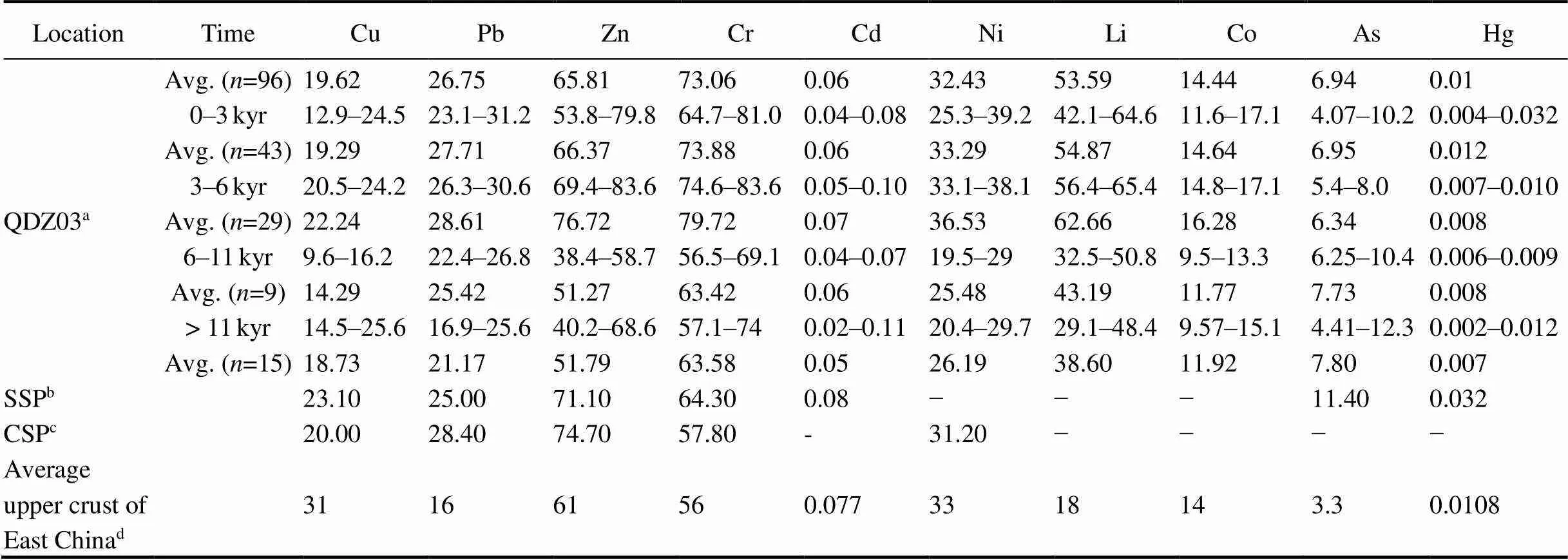
Table 2 Summary of trace metal concentrations in the sediment core and comparison with the average metal concentration in surface sediments (unit: mgkg−1)
Notes: SSP, Southern Shandong Peninsula; CSP, Coastal Shandong Peninsula;arepresents this study;b, c, drepresent the references Liu. (2015), Li. (2013) and Gao. (1998), respectively.
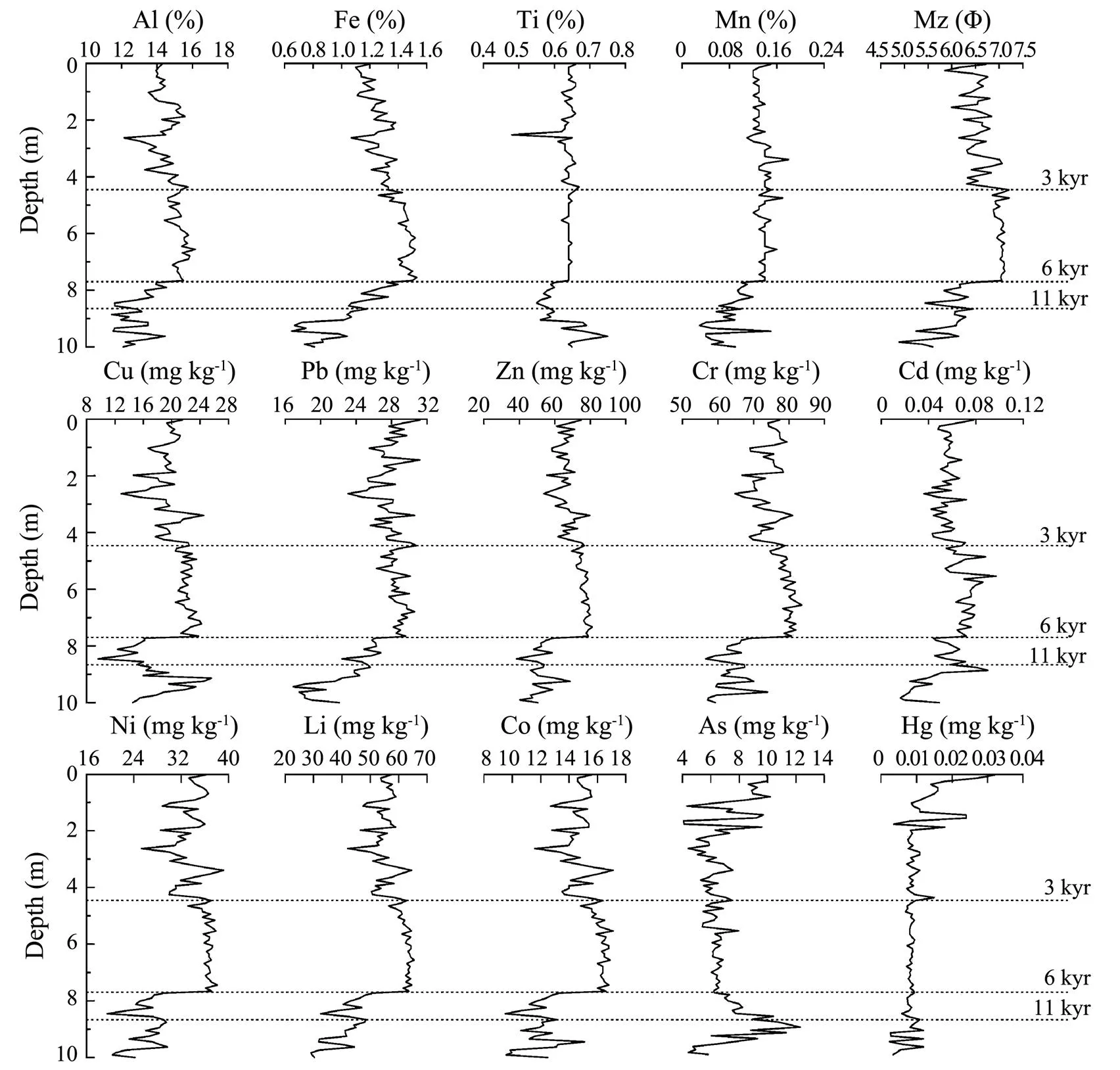
Fig.4 Vertical distribution of major and trace metals and mean grain size (Mz) in the core.
Prior to 6kyr, the lithology along the core changes dra- matically, which resulted in the great shift of metal concentrations. The highest concentration of Ti, Cu and As occurred before 11kyr (Fig.4), but the average concentrations of all metals, except As and Hg, have the higher concentrations during the period of 6–3kyr than those during three other periods (Table 2). Hg has the highest average concentration during 3–0kyr, which may be mainly related to human activities. The high average concentration of As occurred before 6kyr, which should resulted from distinct sediment source. As is a relatively enriched element in the crust, and has a high content in volcanic rocks and pyroclastic rocks. Volcanic rocks are distributed in the Mesozoic depression basin in the study area. During the period of 11–6kyr, the sea level rises gradually and the Yellow Sea circulation has not yet formed, the sediment of the core was mainly derived from the proximal sediments on the Shandong Peninsula, which resulted in the high content of As due to the weathering of volcanic rocks. After 6kyr, the sea level reaches its peak and falls gradually, the Yellow Sea circulation formed and the Yellow River sediment was transported to this area (Qiu., 2014), which resulted in the relatively lower content of As than that during 6–11kyr. Besides, the concentration of Li is much higher than that in the upper crust of East China (Table 2), which may be mainly related to mica and feldspar, the main carrier of Li and the main minerals of granite. There is a large amount of intrusion granite in this study area, which resulted in the high concentration of Li due to their weathering.

Table 3 Pearson’s correlation matrix for the major and trace metal concentrations and Mz (n=96)
Notes:*Correlation is significant at the 0.05 level (two-tailed).**Correlation is significant at the 0.1 level (two-tailed).
Since 6kyr, after the Yellow Sea circulation formed, the sedimentary environment was relatively stable and the lithology in core QDZ03 was uniform. All of metals, except As and Hg, possessed higher average concentrations during 6–3kyr than those during 3–0kyr (Table 2), because of particle size effects. The trace metals were usually adsorbed onto fine grain size sediments in the environment (Quinton and Catt, 2007). The grain size of core sediments during 6–3kyr is between 6.9 and 7.2Φ, with mean grain size 7.03, while during 3–0kyr, the grain size is between 5.85 and 7.2Φ, with average of 6.57Φ (Fig.4). All the trace metal concentrations, except As and Hg, are moderately to strongly correlated with mean grain size (Mz) (=0.62–0.93) (Table 3). So most of the trace metals showed high concentrations in the sediments during 6–3kyr and the average concentrations of all the trace elements during 6–3kyr were selected as the background values.
3.2 Element Interrelations and Assessment in Sediment Core
Pearson correlation coefficients between the concentrations of trace metals (Cu, Pb, Zn, Cr, Cd, As, Hg, Ni, Li, and Co) and selected major metals (Al, Fe, Mn, and Ti), and mean grain size (Mz) are listed in Table 3. The metal concentrations, except those of Ti, Cu, Cd, As, and Hg, are strongly correlated each other, with the correlation coefficient () larger than 0.61 (maximum 0.97); Metals Ti, As and Hg are negatively or weakly correlated with all of the other metals, withis between −0.27 and 0.37. Cu and Cd are moderately correlated with all of the other metals except Ti, As and Hg, within the range of 0.36–0.79. Mz is strongly correlated with all of the metals, except Ti, As and Hg, with r in the range of 0.62–0.93.
The calculatedvalues are summarized in Fig.5 and Table 4. Thevalues for Cu, Pb, Zn, Cr, Cd, As, Hg, Ni, Li, and Co are in the ranges of 0.57 to 1.39, 0.65 to 1.17, 0.63 to 1.12, 0.86 to 1.09, 0.28 to 1.96, 0.65 to 2.39, 0.36 to 4.09, 0.67 to 1.15, 0.56 to 1.11 and 0.69 to 1.23, with the average values of 0.94, 1.00, 0.91, 0.98, 0.88, 1.18, 1.23, 0.95, 0.21 and 0.95, respectively (Table 4), and the following decreasing order: Hg>As>Pb>Cr>Ni>Co>Cu>Li>Zn>Cd. The averages for all the metals are less than 1.5, indicating their natural sources in the sediments. Thevalues for Cd, As and Hg exceed 1.5 in some samples, which account for 2.1%, 16.1% and 17.7% of all analyzed samples in number (Figs.5 and 7a), and primarily occurredin the bottom 2m sediments, indicating anthropogenic sources.
For Cu, Pb, Zn, Cr, Cd, As, Hg, Ni, Li, and Co,geovalues are in the ranges of −1.80 to −0.38, −1.34 to 0.46, −1.58 to −0.50, −1.08 to −0.52, −2.75 to 0.03, −1.22 to 0.37, −2.39 to 1.35, −1.49 to −0.48, −1.69 to −0.52, and −1.36 to −0.51, with the mean values of −0.79, −0.69, −0.83, −0.72, −0.94, −0.49, −0.52, −0.77, −0.84 and −0.77, respectively (Table 4), and the following decreasing trend: As>Hg>Pb>Cr>Co>Ni>Cu>Zn>Li>Cd. Although the averagegeovalues for all the metals are less than 0, thegeovalues of As and Hg exceed 0 in 10.8% and 12.5% of samples (Figs.6 and 7b), respectively. These highgeovalues are primarily observedin the bottom 2m sediments, indicating these two elements are unpolluted-moderately polluted at this stage.
Factor analysis and principal component analysis (PCA)with varimax rotation were used to identify potential trace- metal sources in the core sediments, with the loadings listed in Table 5.

Table 4 Background values, enrichment factors (EF), and geoaccumulation index (Igeo) values of trace metals off the southern Shandong Peninsula
Note:aBackground values of trace metals are the average trace concentration between 6 and 3kyr in the core QDZ03.
Fig.5 Vertical distributions of thevalues for trace elements in the core.

Fig.6 Vertical distributions of the Igeo values for trace elements in the core.

Fig.7 (a) Metal enrichment factors (EF) and (b) geoaccumulation indexes (Igeo) of trace metals in the core sediments.
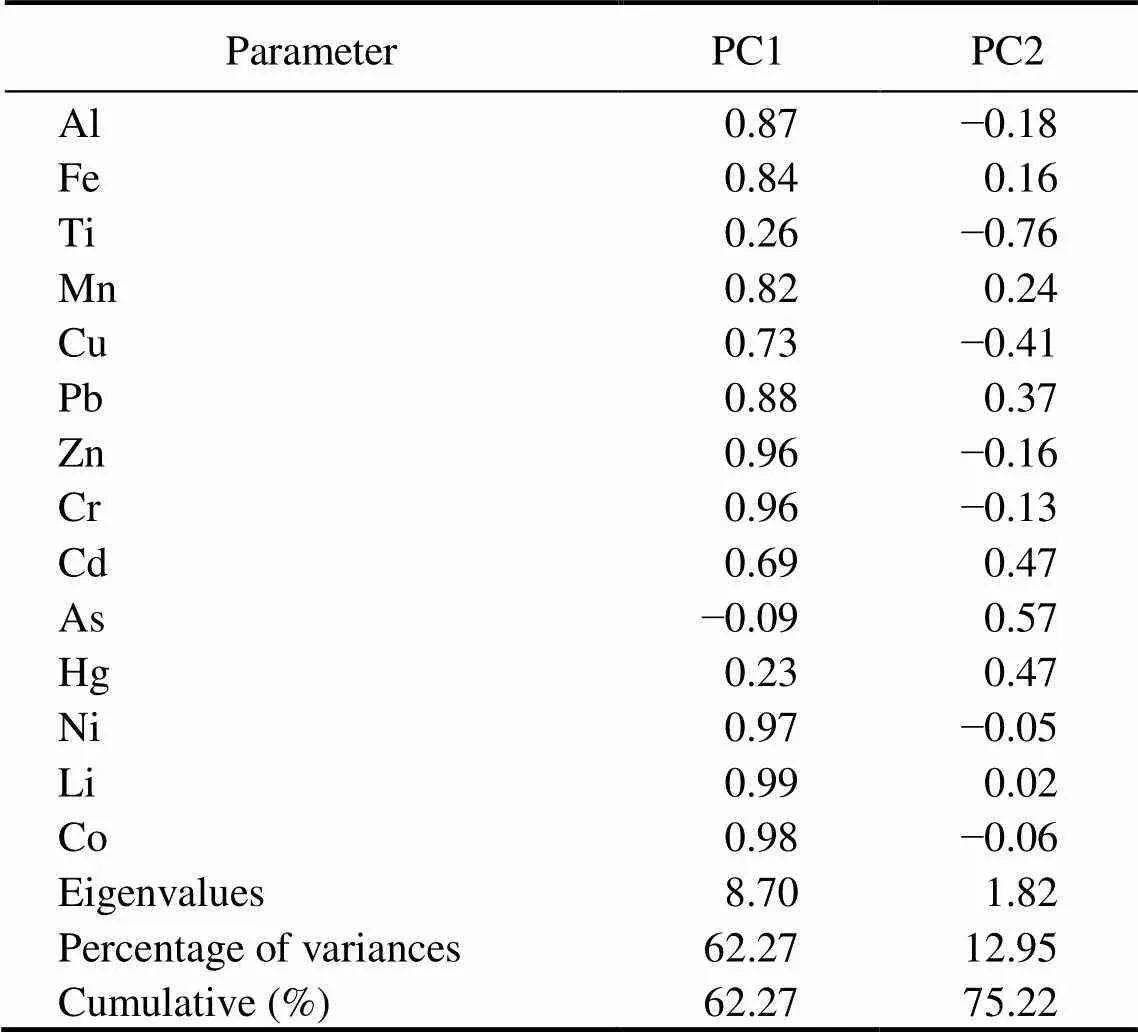
Table 5 Rotated component matrix, eigenvalues, percentage of variances, and eigenvectors for the two principal components (PC1–PC2)
Two principal components, PC1 and PC2, were extracted, which accounted for 75.22% of the total variance (Fig.8). The contribution of PC1 (62.27%) included all of the metals except Ti, As and Hgwith high loadings for Al, Fe, Pb, Zn, Cr, Ni, Li and Co (0.84–0.99). PC1 is considered as the representative of natural sources since elements Al and Fe in the sediments are primarily from lithogenic components and enter the sediments due to the weathering and erosion of rocks and soil parent materials. PC2 accounted for 12.95% of the total variance, with high loadings for As (0.57), Hg (0.47), Cd (0.47) and Pb (0.37). Theandgeovalues of As and Hg in the bottom 2m sediments of exceeded 1.5 and 0 respectively, indicating their anthropogenic sources and unpolluted-moderately polluted degree. Besides, concentration profiles of human activity related elements such as Cu, Pb, Zn, Cr, and Ni, especially As and Hg, present increase trends for the bottom 2m sediments (Fig.4), suggesting that these increases should associated with regional civilization. The concentrations of As and Hg are negatively and weakly correlated with the mean grain size values in sediments (Table 3). The sources of As and Hg are mainly related to human activities, which may have been dominated by industrial and agricultural wastes, either discharged directly or transported from rivers to the coastal area. With the development of economy and urbanization, human activities in the coastal zone increased largely, such as the building of factories, ports, artificial breeding and so on, which resul- ted in the aggravation of environment pollution.

Fig.8 Principal component loading diagram for major and trace metals in the core sediments.
4 Conclusions
Here the vertical distributions of ten trace metals and their pollution status were investigated in the core sediments off the southern Shandong Peninsula. All of the metals, except As and Hg, have similar distribution patterns, which can be divided into four stages with highest concentrations occurred in the 6–3kyr period. The trace- metal concentrations in sediments are primarily related to grain size compositions and sediment sources. The concentrations of all trace metals in the sediments during 6–3kyr could be considered as the background values in the study area. The high concentrations of As and Hg in the bottom 2m sediments may due to anthropogenic activities. Thevalues and PCA analysis suggest that all the me- tals are mainly supplied by natural sources, except the me- tals As and Hg, which were derived from anthropogenic sources in the bottom 2m sediments of the core. The vertical distributions of metals and theirgeovalues indicate that the sediments were not contaminated for metals such as Cu, Zn, Cr, Cd, Pb, Ni, Li and Co, whereas they were contaminated for As and Hg in the bottom 2m sediments.
Acknowledgements
This study was financially supported by the Laboratory for Marine Geology, Qingdao National Laboratory for Ma-rine Science and Technology (No. MGQNLM201801), the China Geological Survey Projects (Nos. GZH200900501, DD20160145 and DD20190276), and the National Natural Science Foundation of China (No. 41706073).
Cao, M., Yao, J., Deng, X., Yang, F., Mao, G., and Mathur, R., 2017. Diverse and multistage Mo, Au, Ag-Pb-Zn and Cu deposits in the Xiong’er Terrane, East Qinling: From Triassic Cu mineralization., 81: 565-574.
Gao, S., Luo, T., Zhang, B., Zhang, H., Han, Y., Zhao, Z., and Hu, Y., 1998. Chemical composition of the continental crust as revealed by studies in East China., 62 (11): 1959-1975.
Gu, X., Kong, X., Wang, W., Zhao, H., Li, J., Tang, S., Yu, J., Li, H., Shi, M., Qiang, M., Yuan, S., and Sun, S., 2019. Distribution and environment assessment of heavy metals in the se- diments of Dingzi Bay, Shandong Peninsula., 35 (3): 13-21.
Gu, Y., and Lin, Q., 2016. Trace metals in a sediment core from the largest mariculture base of the eastern Guangdong coast, South China: Vertical distribution, speciation, and biological risk., 113: 520-525.
He, Z., Yang, S., Zhao, B., Li, X., Xie, J., and Wen, X., 2019. Changes in heavy metal elements in the sediments from Chang- jiang Estuary and their environmental responses in recent 1500 years., 39 (2): 24-33.
Li, C., Zhang, J., Fan, D., and Deng, B., 2001. Holocene regression and the tidal radial sand ridge system formation in the Jiangsu coastal zone, East China., 173: 97- 120.
Li, G., Hu, B., Bi, J., Leng, Q., Xiao, C., and Yang, Z., 2013. Hea- vy metals distribution and contamination in surface sediments of the coastal Shandong Peninsula (Yellow Sea)., 76: 420-426.
Li, Y., and Li, H., 2017. Historical records of trace metals in core sediments from the Lianyungang coastal sea, Jiangsu, China., 116: 56-63.
Liu, J., Yin, P., Chen, X., and Cao, K., 2019. Distribution, enrichment and transport of trace metals in sediments from the Dagu River Estuary in the Jiaozhou Bay, Qingdao, China., 9: 545.
Liu, S., Zhang, Y., Bi, S., Zhang, X., Li, X., Lin, M., and Hu, G., 2015. Heavy metals distribution and environmental quality assessment for sediments off the southern coast of the Shandong Peninsula, China., 100: 483- 485.
Liu, Y., Xiao, T., Ning, Z., Li, H., Tang, J., and Zhou, G., 2013. High cadmium concentration in soil in the Three Gorges region: Geogenic source and potential bioavailability., 37: 149-156.
Mao, G., Hua, R., Gao, J., Zhao, K., Long, G., Lu, H., and Yao, J., 2010. Rare earth element and trace element features of gold-bearing pyrite in the Jinshan Gold Deposit, Jiangxi Pro- vince.–, 84: 614-623.
Qiu, J., Liu, J., Li, M., Wang, S., Bai, W., and Zhang, D., 2018. Assessment of heavy metal contamination in surface sediments from the nearshore zone, southern Jiangsu Province, China., 133: 281-288.
Qiu, J., Liu, J., Saito, Y., Yang, Z., Yue, B., Wang, H., and Kong, X., 2014. Sedimentary evolution of the Holocene subaqueous clinoform off the southern Shandong Peninsula in the western South Yellow Sea., 13 (5): 747-760.
Quinton, J. N., and Catt, J. A., 2007. Enrichment of heavy metals in sediment resulting from soil erosion on agricultural fields., 41: 3495-3500.
Shen, F., Mao, L., Deng, X., Sun, C., Zhu, R., and Ding, M., 2018. Reanalysis of distribution characteristics and contamination evaluation of heavy metals in coastal sediments of Jiang- su Province.,39 (5): 62-71.
Shen, T., Zhang, L., and Li, X., 2012. Geochemical characteristics of rodingite derived from eclogite in western Tianshan, Xinjiang, China and its implication for subduction zone fluid., 28: 2235-2249.
Southon, J., Kashgarian, M., Fontugne, M., Metivier, B., and Yin, W., 2002. Marine reservoir corrections for the Indian Ocean and Southeast Asia., 44: 167-180.
Stuiver, M., and Reimer, P., 1986–2014. Calib Radiocarbon Ca- libration Program. http://calib.org.
Veerasingam, S., Vethamony, P., Mani Murali, R., and Fernandes, B., 2015. Depositional record of trace metals and degree of contamination in core sediments from the Mandovi estuarine mangrove ecosystem, west coast of India., 91: 362-367.
Wang, Z., Wang, J., Du, Q., Deng, Q., and Yang, F., 2013. The evolution of the central Yangtze Block during early Neoarchean time: Evidence from geochronology and geochemistry., 77: 31-44.
Xia, Z., 1987.. Meteorological Press, Beijing, 57.
Xu, F., Hu, B., Dou, Y., Song, Z., Liu, X., Yuan, S., Sun, Z., Li, A., and Yin, X., 2018. Prehistoric heavy metal pollution on the continental shelf off Hainan Island, South China Sea: From natural to anthropogenic impacts around 4.0kyrBP., 28: 455-463.
Xu, G., Liu, J., and Kong, X., 2012. An evaluation on heavy metal contamination in surface sediments on the west South Yellow Sea., 31 (2): 181-185.
Yuan, H., Song, J., Li, X., Li, N., and Duan, L., 2012. Distribution and contamination of heavy metals in surface sediments of the South Yellow Sea., 64 (10): 2151-2159.
Yuan, H., Zhao, G., Li, X., and Ye, S., 2018. Regional distribution of heavy metals in surface sediments of Dafeng coastal wetlands in Yancheng, Jiangsu and its ecological implications., 34 (9): 51-59.
Zhang, J., and Liu, C. L., 2002. Riverine composition and estuarine geochemistry of particulate metals in China–weathering features, anthropogenic impact and chemical fluxes., 54 (6): 1051-1070.
. Tel: 0086-532-85731259
E-mail: jinqingliu@hotmail.com
October 31, 2019;
March 2, 2020;
April 28, 2020
(Edited by Chen Wenwen)
杂志排行
Journal of Ocean University of China的其它文章
- Numerical Simulation and Risk Analysis of Coastal Inundation in Land Reclamation Areas: A Case Study of the Pearl River Estuary
- Variation of Yellow River Runoff and Its Influence on Salinity in Laizhou Bay
- Cold Water in the Lee of the Batanes Islands in the Luzon Strait
- Preliminary Design of a Submerged Support Structure for Floating Wind Turbines
- Inversion of Oceanic Parameters Represented by CTD Utilizing Seismic Multi-Attributes Based on Convolutional Neural Network
- Trace-Norm Regularized Multi-Task Learning for Sea State Bias Estimation
